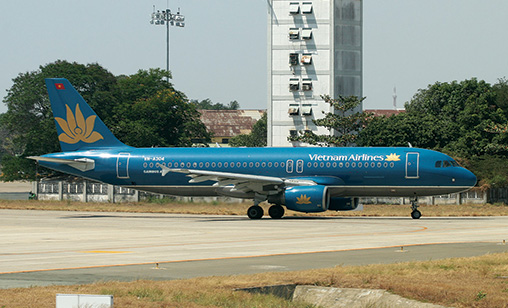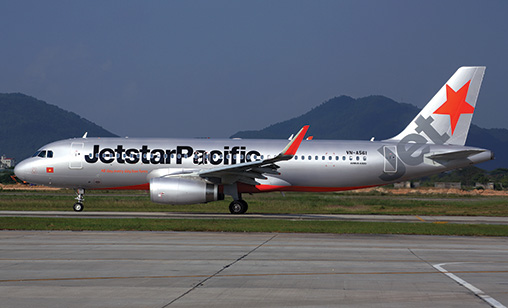News Backgrounder
Upstart VietJet stalking flag carrier in home market
Joint venture partners, Vietnam Airlines and the Qantas Group, are investing more than US$100 million to defend their low-cost carrier, Jetstar Pacific, against agile new budget rivals, led by privately owned LCC comet, VietJet.
June 1st 2016
Analysts are predicting Vietnam Airlines’ (VNA) domination of the country’s domestic market will be overtaken this year by the privately owned and extremely ambitious low-cost carrier, VietJet. Read More »
 |
 |
It is a competitive threat that has galvanized Vietnam’s flag carrier into action in every part of its business – and part of the defensive strategy is to increase the capacity offered by the Vietnam/Australian carrier, Jetstar Pacific.
Early last month, it was revealed the joint venture partners would invest more than US$100 million in their LCC subsidiary by 2020, cash that will allow the airline to increase its fleet from 12 A320 family aircraft to at least 30 of the type.
The Qantas Group, which owns 30% of Jetstar Pacific, will contribute $31 million of the $100 million plus funds injection with majority owner, VNA, putting in $70 million.
But analysts believe that investment in new capacity may not be enough to stop the VietJet juggernaut. With an IPO scheduled later this year that is intended to sell some 30% of VietJet (the maximum allowed under Vietnamese law), consultancy CAPA predicted the five-year-old LCC will hold a dominant 40% share of the domestic market by year end.
Vietjet operates 35 A320 aircraft, with 179 of the type on order plus 91 options. Its goal is a fleet of 70 airliners by 2021. It is Vietnam’s only privately owned airline, run by chief executive, Nguyen Thi Phuong Thao, and is a carrier with global ambitions. “We look at Emirates, which came from a country with a small population and has become a global airline. We want to make VietJet the Emirates of Asia,” she has said.
Official government figures record that Jetstar Pacific had 14.9% of the domestic market last year, with Vietnam Airlines at 40.8% and VietJet at 36.3%.
Although Vietjet is tearing apart VNA’s past domestic market strategy, it is not the only competition that the flag carrier and Jetstar Pacific are facing. In March, the Ministry of Transport asked the government to grant an air transport business licence to operate as a scheduled passenger airline to Vietstar Airlines Multirole Corporation or Vietstar Airlines.
Based in Ho Chi Minh City, the airline was established by the Vietnamese Air Force in 2010 and has mainly operated as a cargo airline, with MRO and pilot training subsidiaries. It plans a fleet of B737s and A320s that will service a network of both domestic and south east and north Asia destinations.
The Civil Aviation Authority of Vietnam (CAAV) has eight Vietnamese airlines registered with the authority: Vietnam Airlines, Jetstar Pacific Airlines, Vietnam Air Services Company (VASCO), VietJet Air, Blue Sky Travel, Event Company Ltd, Hải Âu Airline and Green Planet Technology.
In April, VASCO was renamed SkyViet and will compete in the turboprop market flying ATR72-500s.
Most analysts believe VNA and its partners would face an uphill battle in retaining their present market share and said the effort required to turn around Jetstar Pacific’s performance has been tortuous.
Launched in 2008, it was born out of a restructuring of state-controlled charter cargo carrier, Pacific Airlines, in which Qantas took a 30% shareholding. Four years later, sovereign wealth fund, State Capital Investment Corporation, transferred its 70% equity in the carrier to Vietnam Airlines.
The LCC announced its first ever profit, a meagre $11,800 for 2015, in April. Chief executive, Le Hong Ha, attributed the result to an extended overhaul of operations, cost reductions and cooperation with Vietnam Airlines.
It is generally agreed that Jetstar Pacific has been too slow to change, a situation that has benefitted the much more energetic VietJet. Jetstar Pacific’s passenger traffic grew by 38% in 2015, to 3.6 million. VietJet recorded 70% passenger growth, to around 10 million, and has forecast a 50% expansion this year, to 15 million passengers.
In April, VNA reported a $48 million pre-tax profit for the first quarter of its fiscal year, 32.5% better than in the same period 12 months ago. The carrier said it had operated in a good business environment where the macro-economy had remained stable, accompanied by satisfactory GDP expansion.
In addition, fuel costs were lower and foreign exchange rates had increased against the U.S. dollar, benefitting the airline’s bottom line. In better than expected results for the three months reported, VNA carried more than 4.6 million passengers and nearly 61,000 tonnes of cargo, increases of 11.6% and 11.2%, respectively.
“However, the firm is still faced with many challenges and fluctuations in the market such as increased terrorism in the Europe, particularly after the bombings in Brussels in March, and doubts about the Zika virus’s penetration into Vietnam that affected travelling demand on international routes,” an airline statement said.
“Complicated weather and infrastructure [limitations] at a number of airports also hampered the firm’s implementation of its plans and services.”
The carrier achieved a breakthrough last month when Japan’s All Nippon Airways Holdings (ANAH) confirmed an 8.8% investment in the airline for US$109 million. Vietnam could be an attractive market for ANA with Japanese companies investing in the country as they reduce their exposure to China.
Foreign direct investment by Japanese businesses in Vietnam more than tripled, to $9 billion, from 2011 to 2014 compared with the previous four years, the Japan External Trade Organization records.
Whoever ends up at the top of the Vietnamese aviation pile, there will still be plenty of business for everyone. The International Air Transport Association (IATA) forecast Vietnam will be one of the world’s 10 fastest growing aviation markets in the next two decades.